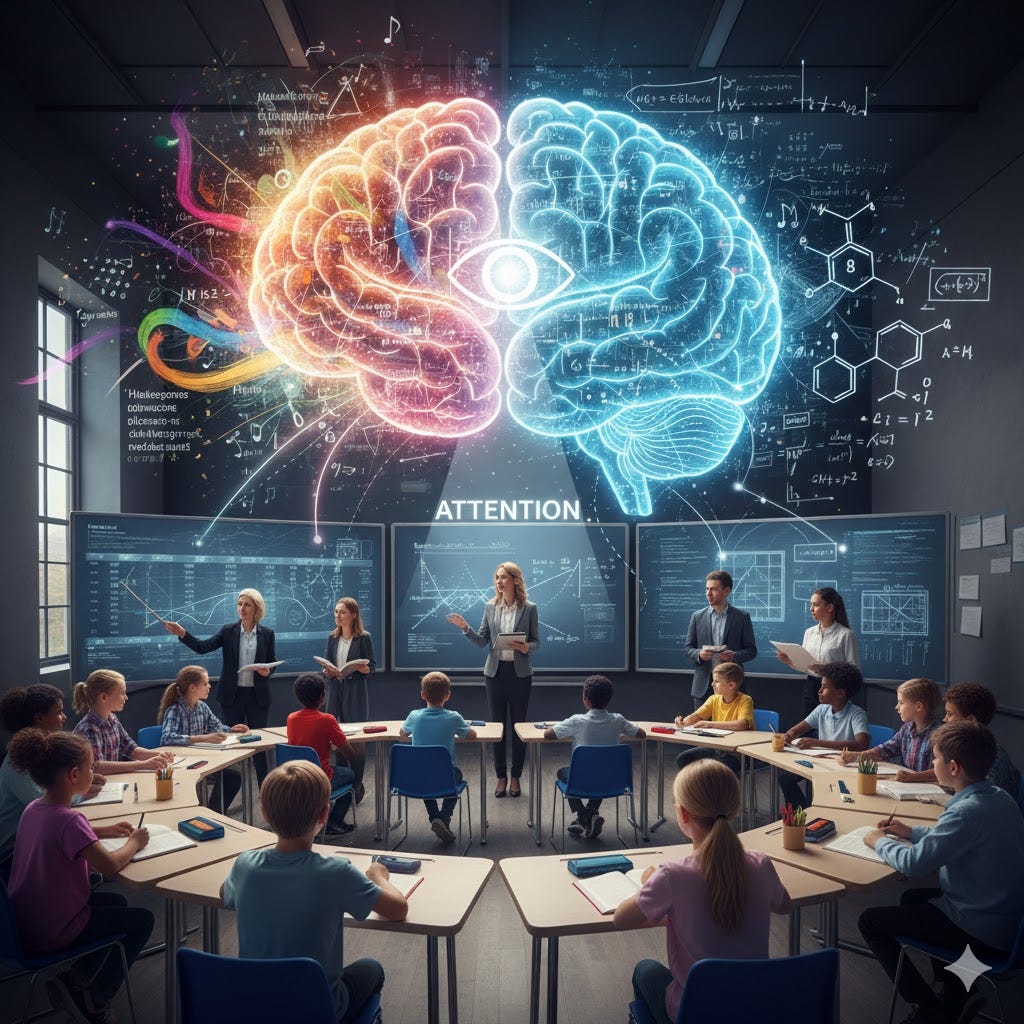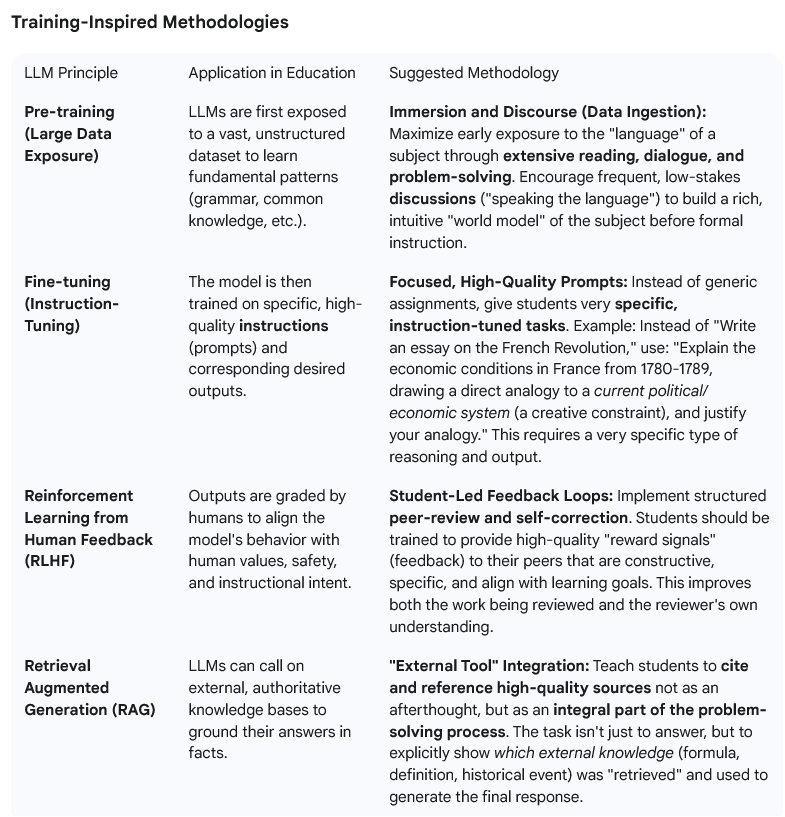Learn teaching methodologies from LLMs
It’s surprising that humans have not learnt from AI yet. What language models have shown is that almost everything is a language(and there are some things which are not). So we have to update our teaching methodologies. Math is a language. It’s tokens are different. But it is a language which can be used to describe concepts unambiguously.
Our languages like English, Telugu etc are ambiguous by nature. A lot can be inferred from context. That’s a feature, not a bug.
Let us see how we can learn about Attention in LLMs and see how we can use those principles in our regular learning. Our neural networks are much better than artificial neural networks :)
1. Teach Everything as a Language
Almost every subject is a language. A language has tokens (vocabulary), grammar (rules), and semantics (meaning). This framework can shift teaching from rote memorization to genuine fluency.
Focus on “Token” and “Grammar” Fluency: Before students can solve complex problems (form “sentences”), they must have instant recall of the basic tokens and grammar.
In Mathematics: The tokens are numbers, variables (x,y), and operators (+,−,×,÷). The grammar includes the order of operations (PEMDAS/BODMAS) and properties of equality. A student’s inability to solve 3(x+2)=18 often isn’t a failure of logic, but a lack of fluency in the “grammatical” rule of distribution. Suggestion: Use short, daily drills on these fundamental rules and tokens, much like vocabulary quizzes, to build automaticity.
In Chemistry: The tokens are element symbols (H, O, C) and the grammar is the set of rules for chemical bonding and balancing equations. Suggestion: Teach students to “read” and “write” chemical formulas as if they are words and sentences describing molecular structures and reactions.
In Music: Tokens are notes; grammar includes scales, chords, and time signatures. Suggestion: Frame music theory not as abstract rules, but as the grammar that allows us to create emotionally resonant “sentences” and “paragraphs.”
Emphasize “Translation” Skills: A key measure of fluency is the ability to translate between languages.
Suggestion: Design exercises that require students to “translate” concepts across domains. For example:
English to Math: Convert a word problem into a precise, unambiguous mathematical equation. This forces clarity of thought.
Science to English: Ask students to describe a complex process, like photosynthesis, in simple, non-technical language. This ensures they haven’t just memorized jargon but truly understand the meaning.
History to Data: Have students represent a historical trend, like population growth or economic change, as a graph (the language of data visualization).
2. Apply “Attention” to the Classroom
The ‘attention mechanism’ in LLMs is revolutionary. It allows the model to weigh the importance of different words in a sentence to understand context and relationships. For example, in “The dog chased the ball until it was tired,” attention helps the model know that “it“ refers to the dog, not the ball. We can apply this principle to guide student attention.
Guided “Self-Attention”: Human attention is naturally limited. Instead of just presenting information, teachers should actively guide students to focus on the connections within the material.
Suggestion: Constantly ask “linking” questions. Don’t just teach Chapter 4 after Chapter 3. Ask, “How does the concept of ‘friction’ in this chapter challenge our previous understanding of ‘motion’?“ or “Which character’s decision in this chapter is a direct result of the event that happened in Chapter 1?“ This forces students’ brains to build a mental map, assigning importance and creating links between concepts, just as an attention mechanism does.
Identify the “Key Tokens”: In any lesson, some ideas carry more weight than others.
Suggestion: Begin or end a lesson by asking students: “If you could only remember three words or one core idea from today’s class, what would it be and why?“ This exercise compels students to perform their own ‘attention’ calculation, sifting through the information to identify the most significant “tokens” that give meaning to the rest.
Multi-Headed Attention (Multiple Perspectives): Advanced LLMs use multiple “attention heads” to look at a sentence from different contextual angles simultaneously.
Suggestion: Teach students to do the same. When studying a historical event like a war, analyze it through different “heads”: the economic perspective, the social perspective, the political perspective, and the perspective of an individual soldier. When solving a math problem, ask if there is a geometric, algebraic, or graphical way to view it. This builds a robust, multi-faceted understanding that is far more resilient than a single-track memorization of facts.
3. Leverage Ambiguity and Unambiguity
The ambiguity of natural language is a feature, enabling nuance, poetry, and context-based inference. In contrast, the power of formal languages like mathematics lies in their precision. Teaching should explicitly address this distinction.
Teach “Context is King”: In subjects like literature and history, the goal is not to find a single right answer but to make a well-argued interpretation based on evidence.
Suggestion: Focus on contextual analysis. Give students a single quote from a novel and ask them to explain its meaning at that specific point in the story, and then how its meaning might change by the end of the book. This trains the sophisticated neural networks of the human brain to handle ambiguity and inference.
Practice “Code-Switching”: Students should become consciously aware of when precision is required and when ambiguity is acceptable.
Suggestion: Create an exercise where students are given a set of vague, everyday statements (e.g., “The economy is doing better”) and are tasked with “translating” them into unambiguous, testable statements (e.g., “The country’s GDP grew by 2% in the last quarter”). This directly teaches the value and function of formal languages as tools for precise description and analysis, validating your point that “Math is a language which can be used to describe concepts unambiguously.”
4. Integrate Reinforcement Learning Principles
Reinforcement learning teaches an agent to make a sequence of decisions in an environment to maximize a cumulative reward. In the classroom, students are the ‘agents,’ learning is the ‘environment,’ and successful understanding or problem-solving are the ‘rewards.’
Define Clear “Reward Signals” (Feedback): In RL, the agent gets feedback on whether its actions were good or bad. In traditional teaching, feedback can be delayed or unclear.
Suggestion: Implement immediate, specific, and actionable feedback loops. This isn’t just about grades; it’s about explaining why an answer was right or wrong.
For Math: Instead of just marking an answer incorrect, provide a hint or point to the specific “grammatical rule” (e.g., “Check your order of operations here”) that needs revision, allowing the student to self-correct and earn the “reward” of a correct solution.
For Writing: Use rubrics that clearly define the ‘rewards’ for specific elements (e.g., clarity of thesis, use of evidence, grammatical accuracy). Provide immediate feedback on one specific area for improvement, let them revise, and then ‘reward’ them for the improvement.
Gamification: Turn learning into a game where points, badges, or progression through levels serve as tangible, immediate rewards. This directly mimics RL’s reward system, motivating continuous engagement.
Encourage “Exploration vs. Exploitation” (Experimentation and Practice): RL agents balance trying new things (”exploration”) with using what they already know works (”exploitation”). Students need this balance too.
Suggestion: Create environments where students are safe to “explore” different approaches to a problem without immediate penalty.
For Science Experiments: Allow students to design their own experimental setups or hypotheses, even if they might not be perfect. The “reward” comes from observing the outcomes and refining their approach.
For Creative Arts: Encourage trying diverse techniques or styles. The ‘reward’ is the unique creation and the learning gained from the process, not just a perfect final product.
Structured Practice (”Exploitation”): Once an effective strategy is found, provide ample opportunities for students to “exploit” that knowledge through practice, solidifying the skill. This could be targeted practice problems, repeated drills, or applying the same concept in different contexts.
Design for “Sequential Decision-Making” (Problem-Solving Pathways): Many real-world problems require a series of steps, where each decision influences the next. RL excels at optimizing these sequences.
Suggestion: Break down complex projects or problems into smaller, manageable steps, and provide feedback at each stage.
For Research Projects: Instead of just a final paper grade, ‘reward’ students for successful completion of stages like topic selection, literature review, outline creation, and drafting. Each step is a ‘decision’ in the learning pathway.
For Coding: Students get immediate feedback (a successful compile, a passing test case) for each correct segment of code, reinforcing the right decisions in a sequence.
The Role of the “Critic” (Metacognition): In some RL architectures (like Actor-Critic), a ‘critic’ evaluates the ‘actor’s’ actions.
Suggestion: Foster metacognition by teaching students to be their own ‘critics.’
Self-Correction: After attempting a problem, ask students, “What was your strategy? Did it work? If not, why? What would you try differently next time?” This empowers them to evaluate their own ‘actions’ and learn from their mistakes, much like an RL agent refining its policy.
Peer Feedback: Encourage students to act as ‘critics’ for each other, providing constructive feedback on ‘actions’ (assignments, presentations) and helping to identify areas for improvement.



